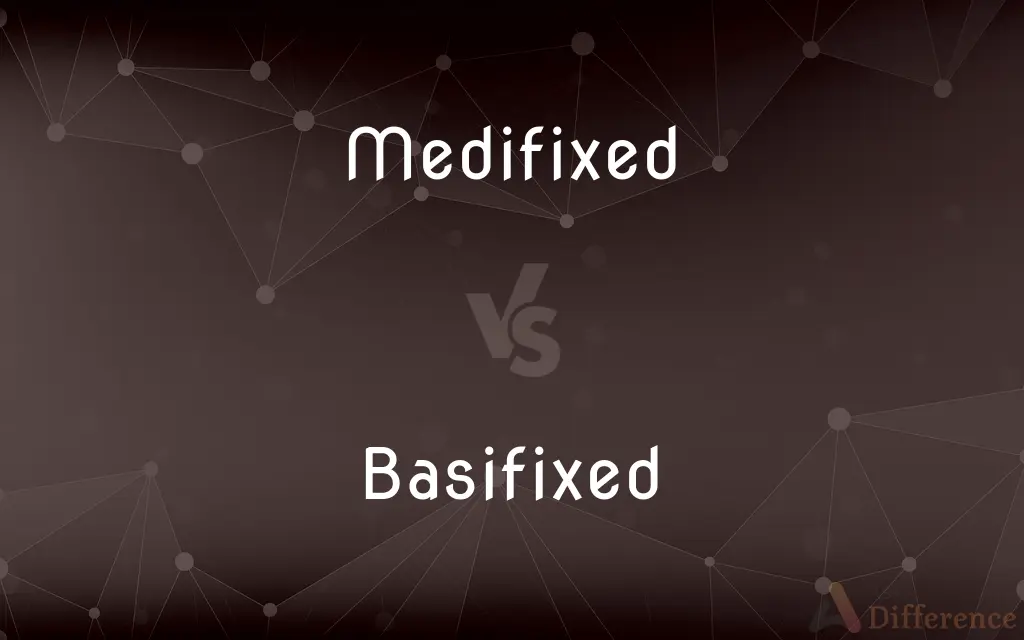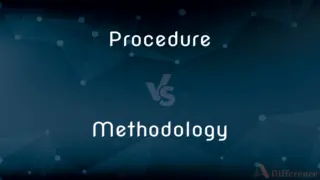Medifixed vs. Basifixed — What's the Difference?
By Tayyaba Rehman & Maham Liaqat — Updated on April 4, 2024
Medifixed refers to anthers attached at their middle to the filament, allowing flexibility, whereas basifixed describes anthers attached at their base, creating a more rigid structure.

Difference Between Medifixed and Basifixed
Table of Contents
ADVERTISEMENT
Key Differences
Medifixed anthers in plants are those where the attachment point to the filament is in the middle of the anther, allowing it to pivot or move more freely. This flexibility can enhance the distribution of pollen as the anther can move with environmental factors like wind or when pollinators visit the flower. Whereas basifixed anthers are attached at their base, limiting movement and potentially focusing pollen release more directly beneath the anther, which might benefit certain pollination strategies where precision in pollen transfer is beneficial.
The medifixed arrangement can be advantageous for plants in open or windy environments where the movement of anthers can help disperse pollen over wider areas, increasing the chances of cross-pollination. On the other hand, basifixed anthers might be found more commonly in flowers that are pollinated by specific insects, as the stable, fixed position can facilitate efficient transfer of pollen onto the visiting pollinator.
In terms of floral morphology, medifixed anthers contribute to a flower's ability to adapt to various pollinators by offering a dynamic mechanism for pollen release. This contrasts with basifixed anthers, which might suggest a more specialized evolutionary path where flowers have adapted to specific pollination agents, reducing the need for anther movement.
From a botanical classification perspective, the distinction between medifixed and basifixed anthers can help in identifying plant species or understanding their evolutionary adaptations. Medifixed anthers suggest a versatile pollination strategy, while basifixed anthers hint at specialization or adaptation to specific ecological niches.
Both medifixed and basifixed anthers play significant roles in the reproductive strategies of flowering plants, but they represent different approaches to achieving successful pollination. Medifixed anthers offer flexibility and adaptability in pollen dispersal, while basifixed anthers provide stability and precision, each adapting to the ecological demands of their environments.
ADVERTISEMENT
Comparison Chart
Attachment Point
Middle of the anther to the filament.
Base of the anther to the filament.
Movement
Allows more freedom and flexibility.
Limited movement, more rigid.
Pollination Strategy
Enhances pollen distribution, adaptable to various pollinators.
Focuses pollen release, possibly for specific pollinators.
Environmental Adaptation
Suited for open or windy environments for broader pollen dispersal.
May be adapted to environments where precision in pollination is key.
Floral Morphology
Suggests a versatile approach to pollination.
Indicates specialization or a specific evolutionary adaptation.
Compare with Definitions
Medifixed
Enhances pollen distribution through flexibility.
Flowers with medifixed anthers adapt well to various pollinating agents.
Basifixed
Anthers attached at their base, providing stability.
The basifixed anthers remained steady, making it easy for bees to collect pollen.
Medifixed
Adaptable to diverse pollination mechanisms.
The plant's medifixed anthers are a trait that aids in its survival in different environments.
Basifixed
Represents a precise approach to pollination.
Basifixed anthers signify the plant's strategy for targeted pollen dispersal.
Medifixed
Indicates a versatile pollination strategy.
Medifixed anthers are indicative of the plant's flexible approach to spreading its pollen.
Basifixed
Focuses pollen release directly beneath the anther.
Basifixed anthers ensure that pollen is efficiently transferred to visiting pollinators.
Medifixed
Anthers attached at the middle to the filament, allowing movement.
The medifixed anthers swayed gently in the breeze, releasing pollen.
Basifixed
Implies a specialized evolutionary adaptation.
The presence of basifixed anthers suggests a long-term adaptation to a niche environment.
Medifixed
Offers a dynamic mechanism for pollen release.
Medifixed anthers contribute to the flower's ability to attract a range of pollinators.
Basifixed
Suited for specific insect pollinators.
Flowers with basifixed anthers have evolved alongside their primary pollinators.
Medifixed
(botany) Of an anther group: attached to the filament at a point somewhere along the length of its connective.
Basifixed
Attached by the base, as certain anthers are to their filaments.
Basifixed
(botany) Said of anthers that are attached to the filament at the base and pointing away from the filament.
Basifixed
Attached by its base (as certain anthers to their filaments or stalks)
Common Curiosities
How do medifixed anthers adapt to windy environments?
Their flexibility allows them to move with the wind, dispersing pollen over a wider area and increasing cross-pollination chances.
What defines an anther as medifixed?
An anther is considered medifixed when it is attached at its middle to the filament, allowing it to move freely.
Why are basifixed anthers important for some plants?
Basifixed anthers provide stability and precision in pollen release, which is crucial for plants relying on specific pollinators.
Can the type of anther attachment affect a plant's pollination success?
Yes, the attachment (medifixed or basifixed) influences how pollen is distributed and can affect pollination efficiency.
Are basifixed anthers less adaptive than medifixed ones?
Not necessarily; basifixed anthers may indicate specialization and adaptation to specific ecological niches or pollinators.
Why might a botanist be interested in whether an anther is medifixed or basifixed?
This distinction helps in plant identification and understanding evolutionary relationships and pollination strategies.
How do medifixed anthers enhance a plant's interaction with pollinators?
Their movement can attract various pollinators and facilitate effective pollen transfer in different conditions.
Can a plant have both medifixed and basifixed anthers?
Typically, a plant species will have one type of anther attachment, as it reflects their evolutionary adaptation to pollination strategies.
How does the environment influence the evolution of medifixed versus basifixed anthers?
Plants evolve these traits in response to their environments and pollination needs, with each type offering advantages in certain conditions.
Is there a correlation between anther attachment and flower shape?
Anther attachment can influence overall floral morphology, which in turn may be adapted to specific pollination strategies.
Share Your Discovery

Previous Comparison
Crystallise vs. Crystallize
Next Comparison
Procedure vs. MethodologyAuthor Spotlight
Written by
Tayyaba RehmanTayyaba Rehman is a distinguished writer, currently serving as a primary contributor to askdifference.com. As a researcher in semantics and etymology, Tayyaba's passion for the complexity of languages and their distinctions has found a perfect home on the platform. Tayyaba delves into the intricacies of language, distinguishing between commonly confused words and phrases, thereby providing clarity for readers worldwide.
Co-written by
Maham Liaqat













































